British Millerian: Strategies for International Market Entry Report
VerifiedAdded on 2022/12/28
|13
|4381
|4
Report
AI Summary
This report examines the strategies for small and medium enterprises (SMEs) to expand into new and international markets, using British Millerian as a case study. It begins by explaining the global business environment and its impact on SMEs, including an analysis of threats and opportunities. The report then delves into international trade, analyzing the benefits of trading blocs and agreements, as well as various traffic and non-traffic barriers. It discusses the advantages and disadvantages of importing and exporting, differentiating between merchandise and service trade. Finally, the report evaluates different methods SMEs can use to enter international markets, comparing and contrasting various entry modes, along with their pros and cons, to provide a comprehensive overview of international market expansion strategies. The report concludes with a summary of key findings and recommendations for SMEs seeking global growth.
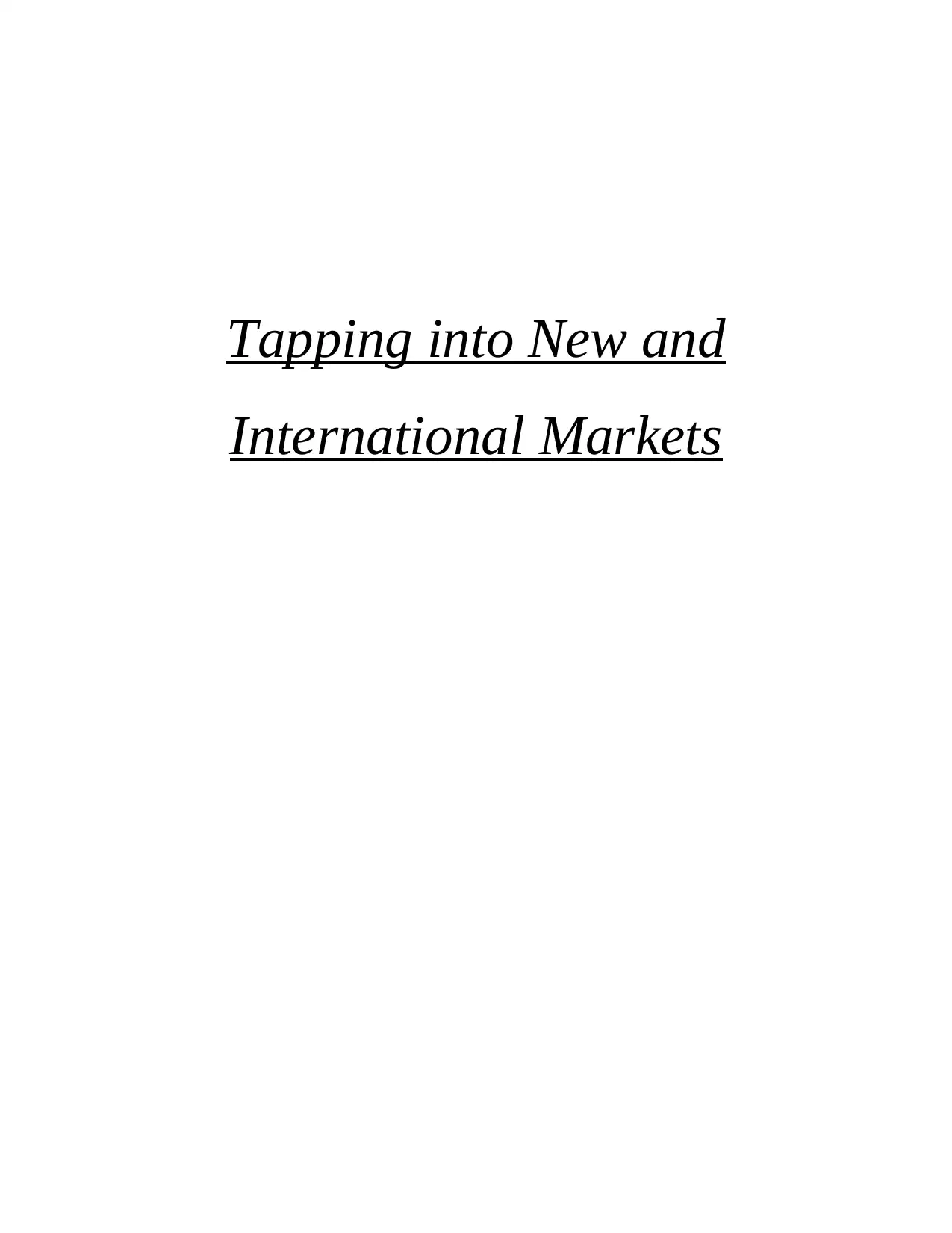
Tapping into New and
International Markets
International Markets
Paraphrase This Document
Need a fresh take? Get an instant paraphrase of this document with our AI Paraphraser
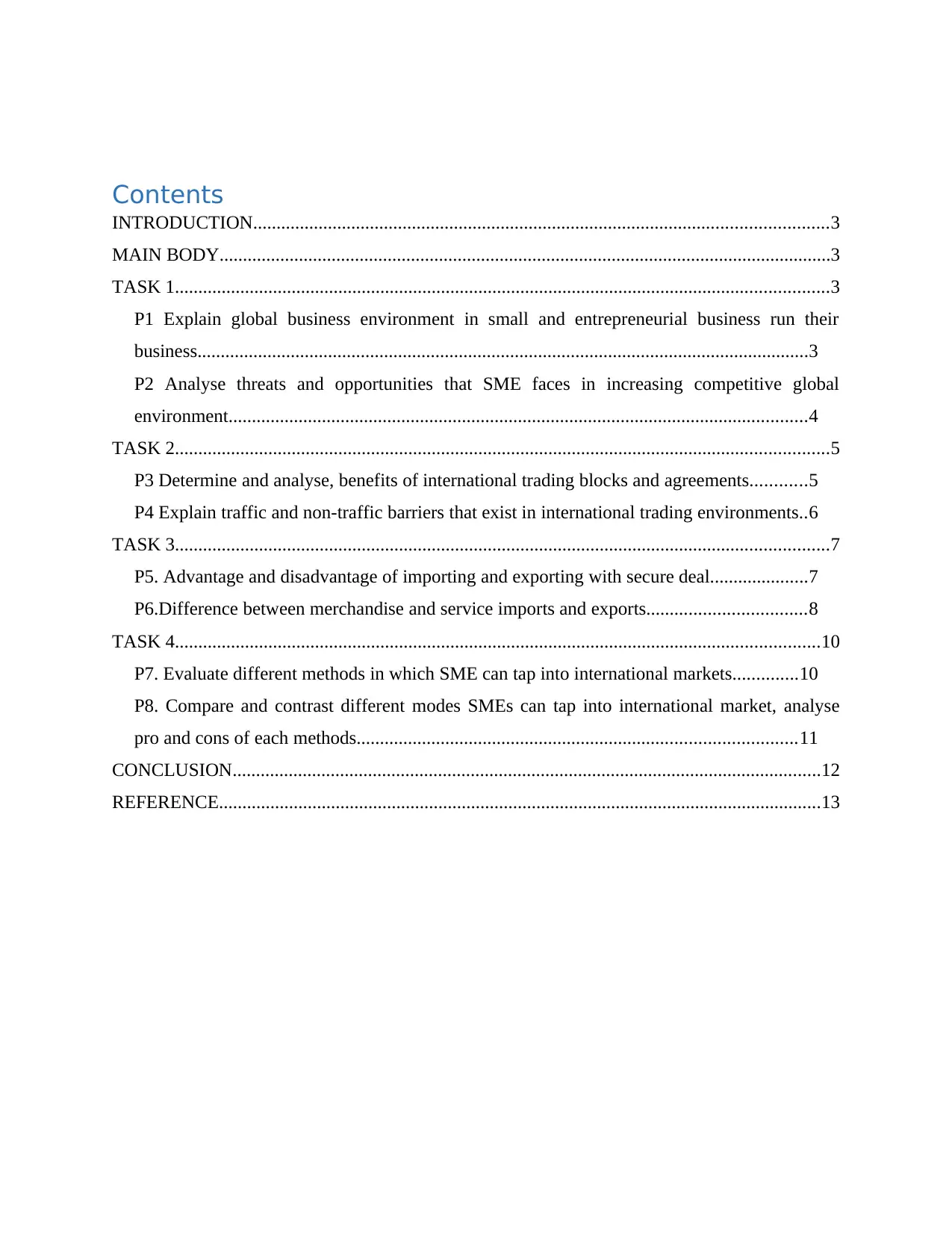
Contents
INTRODUCTION...........................................................................................................................3
MAIN BODY...................................................................................................................................3
TASK 1............................................................................................................................................3
P1 Explain global business environment in small and entrepreneurial business run their
business...................................................................................................................................3
P2 Analyse threats and opportunities that SME faces in increasing competitive global
environment............................................................................................................................4
TASK 2............................................................................................................................................5
P3 Determine and analyse, benefits of international trading blocks and agreements............5
P4 Explain traffic and non-traffic barriers that exist in international trading environments..6
TASK 3............................................................................................................................................7
P5. Advantage and disadvantage of importing and exporting with secure deal.....................7
P6.Difference between merchandise and service imports and exports..................................8
TASK 4..........................................................................................................................................10
P7. Evaluate different methods in which SME can tap into international markets..............10
P8. Compare and contrast different modes SMEs can tap into international market, analyse
pro and cons of each methods..............................................................................................11
CONCLUSION..............................................................................................................................12
REFERENCE.................................................................................................................................13
INTRODUCTION...........................................................................................................................3
MAIN BODY...................................................................................................................................3
TASK 1............................................................................................................................................3
P1 Explain global business environment in small and entrepreneurial business run their
business...................................................................................................................................3
P2 Analyse threats and opportunities that SME faces in increasing competitive global
environment............................................................................................................................4
TASK 2............................................................................................................................................5
P3 Determine and analyse, benefits of international trading blocks and agreements............5
P4 Explain traffic and non-traffic barriers that exist in international trading environments..6
TASK 3............................................................................................................................................7
P5. Advantage and disadvantage of importing and exporting with secure deal.....................7
P6.Difference between merchandise and service imports and exports..................................8
TASK 4..........................................................................................................................................10
P7. Evaluate different methods in which SME can tap into international markets..............10
P8. Compare and contrast different modes SMEs can tap into international market, analyse
pro and cons of each methods..............................................................................................11
CONCLUSION..............................................................................................................................12
REFERENCE.................................................................................................................................13
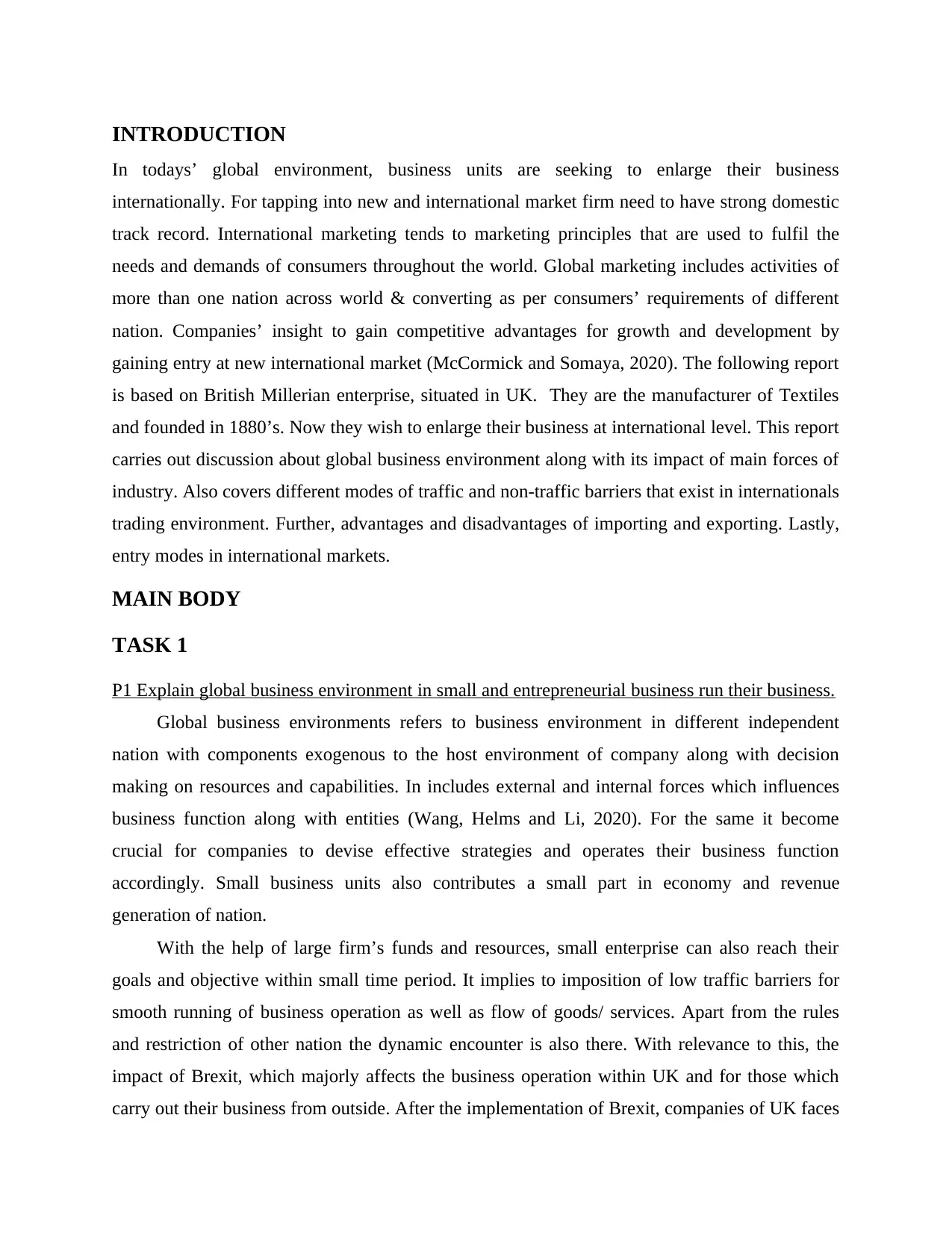
INTRODUCTION
In todays’ global environment, business units are seeking to enlarge their business
internationally. For tapping into new and international market firm need to have strong domestic
track record. International marketing tends to marketing principles that are used to fulfil the
needs and demands of consumers throughout the world. Global marketing includes activities of
more than one nation across world & converting as per consumers’ requirements of different
nation. Companies’ insight to gain competitive advantages for growth and development by
gaining entry at new international market (McCormick and Somaya, 2020). The following report
is based on British Millerian enterprise, situated in UK. They are the manufacturer of Textiles
and founded in 1880’s. Now they wish to enlarge their business at international level. This report
carries out discussion about global business environment along with its impact of main forces of
industry. Also covers different modes of traffic and non-traffic barriers that exist in internationals
trading environment. Further, advantages and disadvantages of importing and exporting. Lastly,
entry modes in international markets.
MAIN BODY
TASK 1
P1 Explain global business environment in small and entrepreneurial business run their business.
Global business environments refers to business environment in different independent
nation with components exogenous to the host environment of company along with decision
making on resources and capabilities. In includes external and internal forces which influences
business function along with entities (Wang, Helms and Li, 2020). For the same it become
crucial for companies to devise effective strategies and operates their business function
accordingly. Small business units also contributes a small part in economy and revenue
generation of nation.
With the help of large firm’s funds and resources, small enterprise can also reach their
goals and objective within small time period. It implies to imposition of low traffic barriers for
smooth running of business operation as well as flow of goods/ services. Apart from the rules
and restriction of other nation the dynamic encounter is also there. With relevance to this, the
impact of Brexit, which majorly affects the business operation within UK and for those which
carry out their business from outside. After the implementation of Brexit, companies of UK faces
In todays’ global environment, business units are seeking to enlarge their business
internationally. For tapping into new and international market firm need to have strong domestic
track record. International marketing tends to marketing principles that are used to fulfil the
needs and demands of consumers throughout the world. Global marketing includes activities of
more than one nation across world & converting as per consumers’ requirements of different
nation. Companies’ insight to gain competitive advantages for growth and development by
gaining entry at new international market (McCormick and Somaya, 2020). The following report
is based on British Millerian enterprise, situated in UK. They are the manufacturer of Textiles
and founded in 1880’s. Now they wish to enlarge their business at international level. This report
carries out discussion about global business environment along with its impact of main forces of
industry. Also covers different modes of traffic and non-traffic barriers that exist in internationals
trading environment. Further, advantages and disadvantages of importing and exporting. Lastly,
entry modes in international markets.
MAIN BODY
TASK 1
P1 Explain global business environment in small and entrepreneurial business run their business.
Global business environments refers to business environment in different independent
nation with components exogenous to the host environment of company along with decision
making on resources and capabilities. In includes external and internal forces which influences
business function along with entities (Wang, Helms and Li, 2020). For the same it become
crucial for companies to devise effective strategies and operates their business function
accordingly. Small business units also contributes a small part in economy and revenue
generation of nation.
With the help of large firm’s funds and resources, small enterprise can also reach their
goals and objective within small time period. It implies to imposition of low traffic barriers for
smooth running of business operation as well as flow of goods/ services. Apart from the rules
and restriction of other nation the dynamic encounter is also there. With relevance to this, the
impact of Brexit, which majorly affects the business operation within UK and for those which
carry out their business from outside. After the implementation of Brexit, companies of UK faces
⊘ This is a preview!⊘
Do you want full access?
Subscribe today to unlock all pages.

Trusted by 1+ million students worldwide
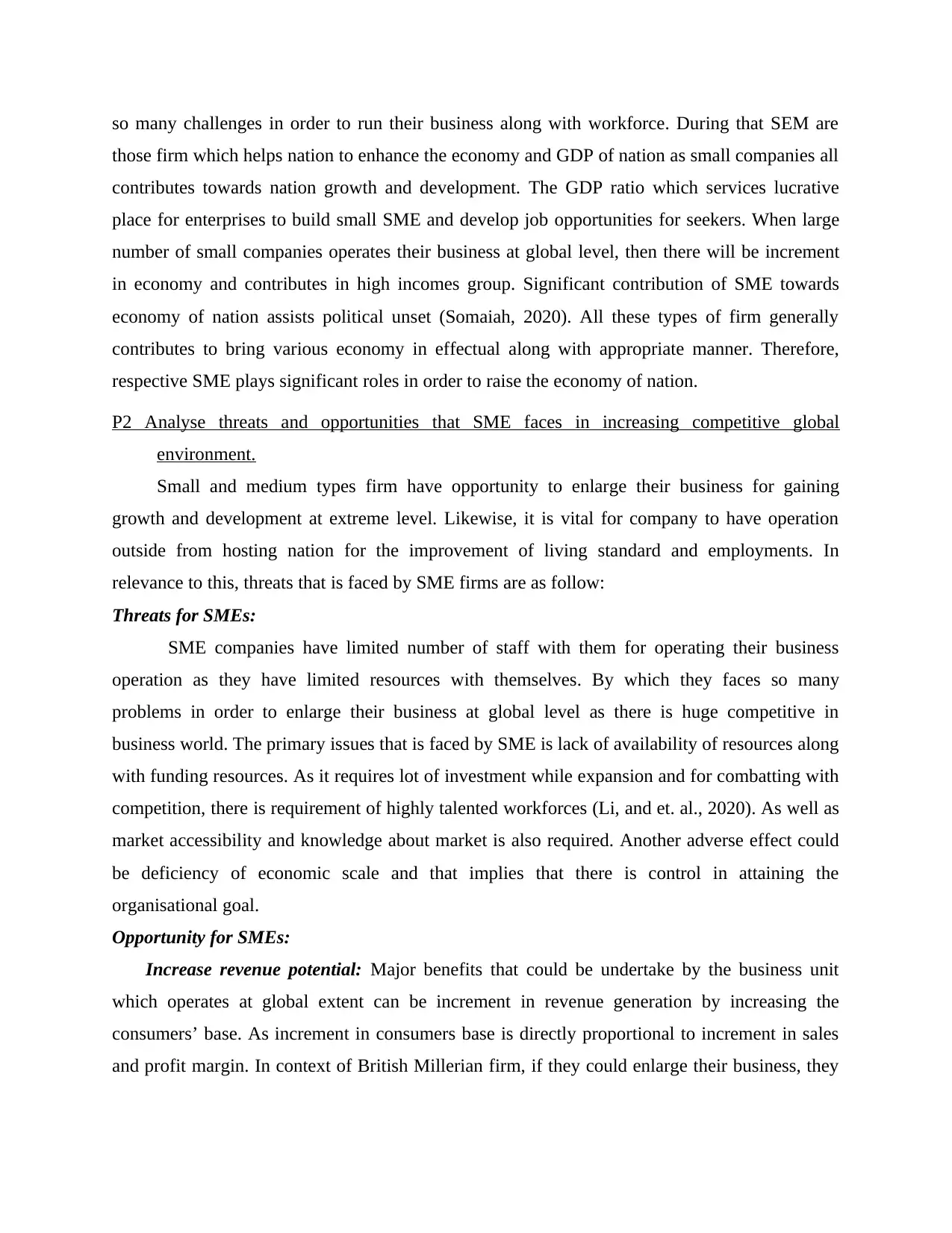
so many challenges in order to run their business along with workforce. During that SEM are
those firm which helps nation to enhance the economy and GDP of nation as small companies all
contributes towards nation growth and development. The GDP ratio which services lucrative
place for enterprises to build small SME and develop job opportunities for seekers. When large
number of small companies operates their business at global level, then there will be increment
in economy and contributes in high incomes group. Significant contribution of SME towards
economy of nation assists political unset (Somaiah, 2020). All these types of firm generally
contributes to bring various economy in effectual along with appropriate manner. Therefore,
respective SME plays significant roles in order to raise the economy of nation.
P2 Analyse threats and opportunities that SME faces in increasing competitive global
environment.
Small and medium types firm have opportunity to enlarge their business for gaining
growth and development at extreme level. Likewise, it is vital for company to have operation
outside from hosting nation for the improvement of living standard and employments. In
relevance to this, threats that is faced by SME firms are as follow:
Threats for SMEs:
SME companies have limited number of staff with them for operating their business
operation as they have limited resources with themselves. By which they faces so many
problems in order to enlarge their business at global level as there is huge competitive in
business world. The primary issues that is faced by SME is lack of availability of resources along
with funding resources. As it requires lot of investment while expansion and for combatting with
competition, there is requirement of highly talented workforces (Li, and et. al., 2020). As well as
market accessibility and knowledge about market is also required. Another adverse effect could
be deficiency of economic scale and that implies that there is control in attaining the
organisational goal.
Opportunity for SMEs:
Increase revenue potential: Major benefits that could be undertake by the business unit
which operates at global extent can be increment in revenue generation by increasing the
consumers’ base. As increment in consumers base is directly proportional to increment in sales
and profit margin. In context of British Millerian firm, if they could enlarge their business, they
those firm which helps nation to enhance the economy and GDP of nation as small companies all
contributes towards nation growth and development. The GDP ratio which services lucrative
place for enterprises to build small SME and develop job opportunities for seekers. When large
number of small companies operates their business at global level, then there will be increment
in economy and contributes in high incomes group. Significant contribution of SME towards
economy of nation assists political unset (Somaiah, 2020). All these types of firm generally
contributes to bring various economy in effectual along with appropriate manner. Therefore,
respective SME plays significant roles in order to raise the economy of nation.
P2 Analyse threats and opportunities that SME faces in increasing competitive global
environment.
Small and medium types firm have opportunity to enlarge their business for gaining
growth and development at extreme level. Likewise, it is vital for company to have operation
outside from hosting nation for the improvement of living standard and employments. In
relevance to this, threats that is faced by SME firms are as follow:
Threats for SMEs:
SME companies have limited number of staff with them for operating their business
operation as they have limited resources with themselves. By which they faces so many
problems in order to enlarge their business at global level as there is huge competitive in
business world. The primary issues that is faced by SME is lack of availability of resources along
with funding resources. As it requires lot of investment while expansion and for combatting with
competition, there is requirement of highly talented workforces (Li, and et. al., 2020). As well as
market accessibility and knowledge about market is also required. Another adverse effect could
be deficiency of economic scale and that implies that there is control in attaining the
organisational goal.
Opportunity for SMEs:
Increase revenue potential: Major benefits that could be undertake by the business unit
which operates at global extent can be increment in revenue generation by increasing the
consumers’ base. As increment in consumers base is directly proportional to increment in sales
and profit margin. In context of British Millerian firm, if they could enlarge their business, they
Paraphrase This Document
Need a fresh take? Get an instant paraphrase of this document with our AI Paraphraser
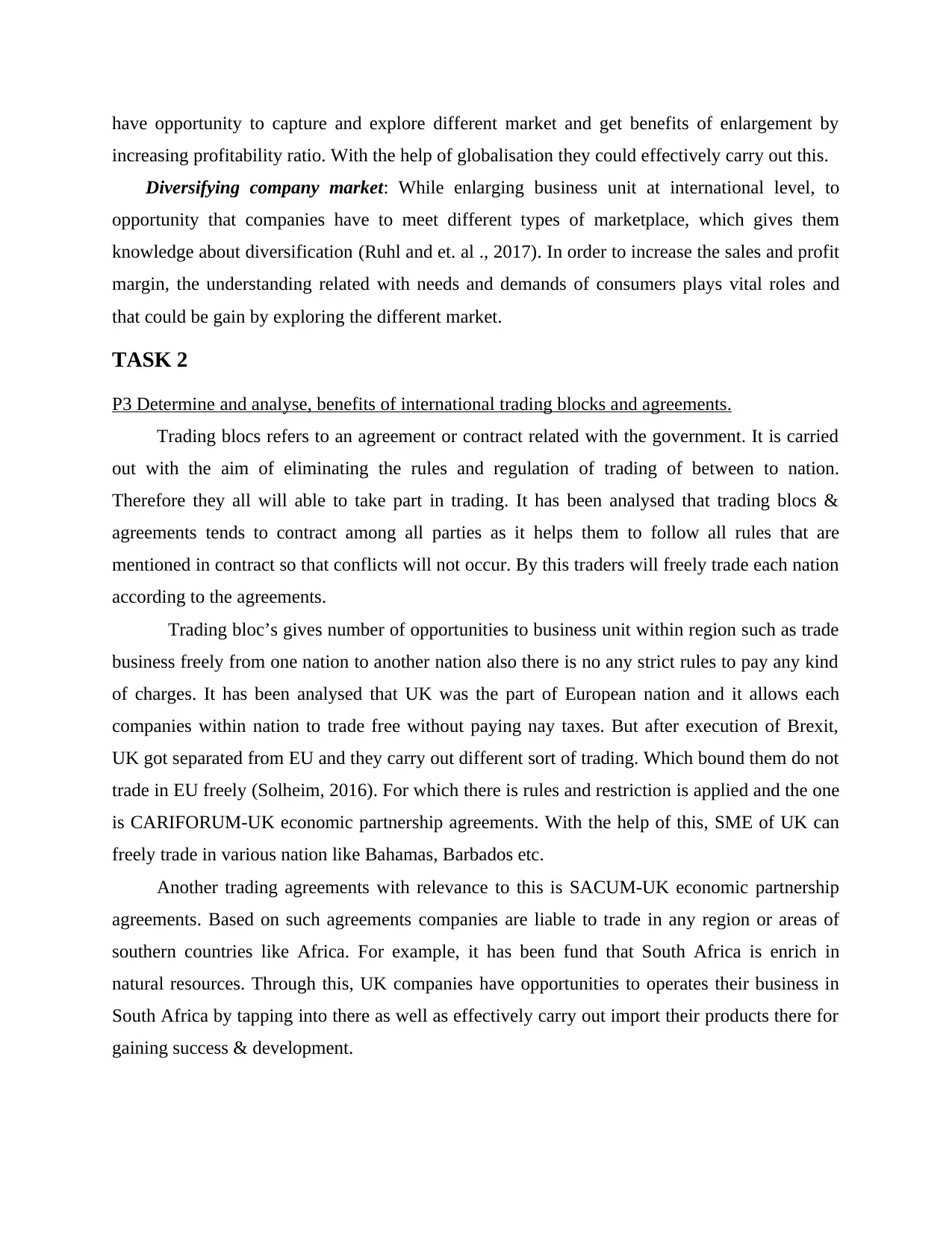
have opportunity to capture and explore different market and get benefits of enlargement by
increasing profitability ratio. With the help of globalisation they could effectively carry out this.
Diversifying company market: While enlarging business unit at international level, to
opportunity that companies have to meet different types of marketplace, which gives them
knowledge about diversification (Ruhl and et. al ., 2017). In order to increase the sales and profit
margin, the understanding related with needs and demands of consumers plays vital roles and
that could be gain by exploring the different market.
TASK 2
P3 Determine and analyse, benefits of international trading blocks and agreements.
Trading blocs refers to an agreement or contract related with the government. It is carried
out with the aim of eliminating the rules and regulation of trading of between to nation.
Therefore they all will able to take part in trading. It has been analysed that trading blocs &
agreements tends to contract among all parties as it helps them to follow all rules that are
mentioned in contract so that conflicts will not occur. By this traders will freely trade each nation
according to the agreements.
Trading bloc’s gives number of opportunities to business unit within region such as trade
business freely from one nation to another nation also there is no any strict rules to pay any kind
of charges. It has been analysed that UK was the part of European nation and it allows each
companies within nation to trade free without paying nay taxes. But after execution of Brexit,
UK got separated from EU and they carry out different sort of trading. Which bound them do not
trade in EU freely (Solheim, 2016). For which there is rules and restriction is applied and the one
is CARIFORUM-UK economic partnership agreements. With the help of this, SME of UK can
freely trade in various nation like Bahamas, Barbados etc.
Another trading agreements with relevance to this is SACUM-UK economic partnership
agreements. Based on such agreements companies are liable to trade in any region or areas of
southern countries like Africa. For example, it has been fund that South Africa is enrich in
natural resources. Through this, UK companies have opportunities to operates their business in
South Africa by tapping into there as well as effectively carry out import their products there for
gaining success & development.
increasing profitability ratio. With the help of globalisation they could effectively carry out this.
Diversifying company market: While enlarging business unit at international level, to
opportunity that companies have to meet different types of marketplace, which gives them
knowledge about diversification (Ruhl and et. al ., 2017). In order to increase the sales and profit
margin, the understanding related with needs and demands of consumers plays vital roles and
that could be gain by exploring the different market.
TASK 2
P3 Determine and analyse, benefits of international trading blocks and agreements.
Trading blocs refers to an agreement or contract related with the government. It is carried
out with the aim of eliminating the rules and regulation of trading of between to nation.
Therefore they all will able to take part in trading. It has been analysed that trading blocs &
agreements tends to contract among all parties as it helps them to follow all rules that are
mentioned in contract so that conflicts will not occur. By this traders will freely trade each nation
according to the agreements.
Trading bloc’s gives number of opportunities to business unit within region such as trade
business freely from one nation to another nation also there is no any strict rules to pay any kind
of charges. It has been analysed that UK was the part of European nation and it allows each
companies within nation to trade free without paying nay taxes. But after execution of Brexit,
UK got separated from EU and they carry out different sort of trading. Which bound them do not
trade in EU freely (Solheim, 2016). For which there is rules and restriction is applied and the one
is CARIFORUM-UK economic partnership agreements. With the help of this, SME of UK can
freely trade in various nation like Bahamas, Barbados etc.
Another trading agreements with relevance to this is SACUM-UK economic partnership
agreements. Based on such agreements companies are liable to trade in any region or areas of
southern countries like Africa. For example, it has been fund that South Africa is enrich in
natural resources. Through this, UK companies have opportunities to operates their business in
South Africa by tapping into there as well as effectively carry out import their products there for
gaining success & development.
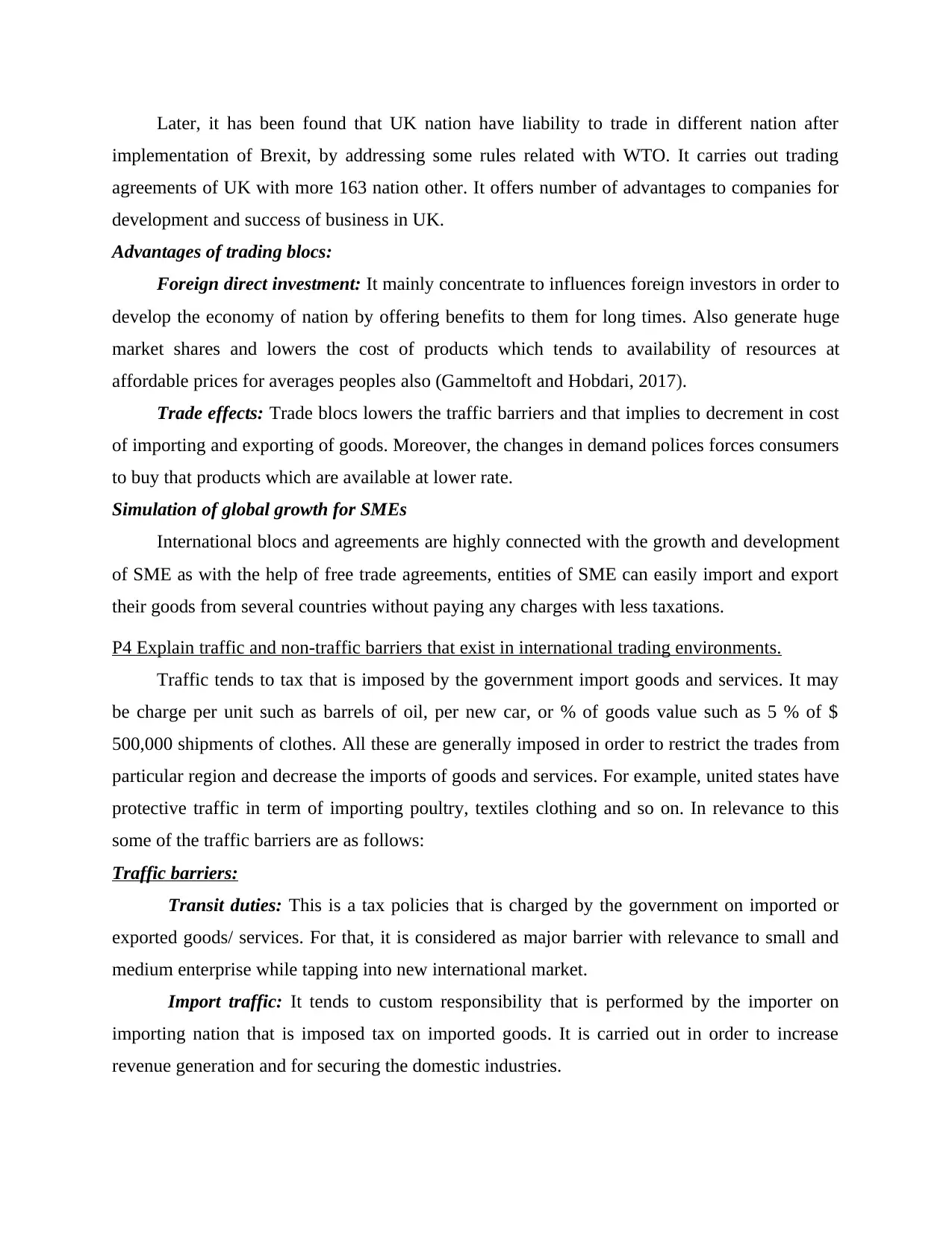
Later, it has been found that UK nation have liability to trade in different nation after
implementation of Brexit, by addressing some rules related with WTO. It carries out trading
agreements of UK with more 163 nation other. It offers number of advantages to companies for
development and success of business in UK.
Advantages of trading blocs:
Foreign direct investment: It mainly concentrate to influences foreign investors in order to
develop the economy of nation by offering benefits to them for long times. Also generate huge
market shares and lowers the cost of products which tends to availability of resources at
affordable prices for averages peoples also (Gammeltoft and Hobdari, 2017).
Trade effects: Trade blocs lowers the traffic barriers and that implies to decrement in cost
of importing and exporting of goods. Moreover, the changes in demand polices forces consumers
to buy that products which are available at lower rate.
Simulation of global growth for SMEs
International blocs and agreements are highly connected with the growth and development
of SME as with the help of free trade agreements, entities of SME can easily import and export
their goods from several countries without paying any charges with less taxations.
P4 Explain traffic and non-traffic barriers that exist in international trading environments.
Traffic tends to tax that is imposed by the government import goods and services. It may
be charge per unit such as barrels of oil, per new car, or % of goods value such as 5 % of $
500,000 shipments of clothes. All these are generally imposed in order to restrict the trades from
particular region and decrease the imports of goods and services. For example, united states have
protective traffic in term of importing poultry, textiles clothing and so on. In relevance to this
some of the traffic barriers are as follows:
Traffic barriers:
Transit duties: This is a tax policies that is charged by the government on imported or
exported goods/ services. For that, it is considered as major barrier with relevance to small and
medium enterprise while tapping into new international market.
Import traffic: It tends to custom responsibility that is performed by the importer on
importing nation that is imposed tax on imported goods. It is carried out in order to increase
revenue generation and for securing the domestic industries.
implementation of Brexit, by addressing some rules related with WTO. It carries out trading
agreements of UK with more 163 nation other. It offers number of advantages to companies for
development and success of business in UK.
Advantages of trading blocs:
Foreign direct investment: It mainly concentrate to influences foreign investors in order to
develop the economy of nation by offering benefits to them for long times. Also generate huge
market shares and lowers the cost of products which tends to availability of resources at
affordable prices for averages peoples also (Gammeltoft and Hobdari, 2017).
Trade effects: Trade blocs lowers the traffic barriers and that implies to decrement in cost
of importing and exporting of goods. Moreover, the changes in demand polices forces consumers
to buy that products which are available at lower rate.
Simulation of global growth for SMEs
International blocs and agreements are highly connected with the growth and development
of SME as with the help of free trade agreements, entities of SME can easily import and export
their goods from several countries without paying any charges with less taxations.
P4 Explain traffic and non-traffic barriers that exist in international trading environments.
Traffic tends to tax that is imposed by the government import goods and services. It may
be charge per unit such as barrels of oil, per new car, or % of goods value such as 5 % of $
500,000 shipments of clothes. All these are generally imposed in order to restrict the trades from
particular region and decrease the imports of goods and services. For example, united states have
protective traffic in term of importing poultry, textiles clothing and so on. In relevance to this
some of the traffic barriers are as follows:
Traffic barriers:
Transit duties: This is a tax policies that is charged by the government on imported or
exported goods/ services. For that, it is considered as major barrier with relevance to small and
medium enterprise while tapping into new international market.
Import traffic: It tends to custom responsibility that is performed by the importer on
importing nation that is imposed tax on imported goods. It is carried out in order to increase
revenue generation and for securing the domestic industries.
⊘ This is a preview!⊘
Do you want full access?
Subscribe today to unlock all pages.

Trusted by 1+ million students worldwide
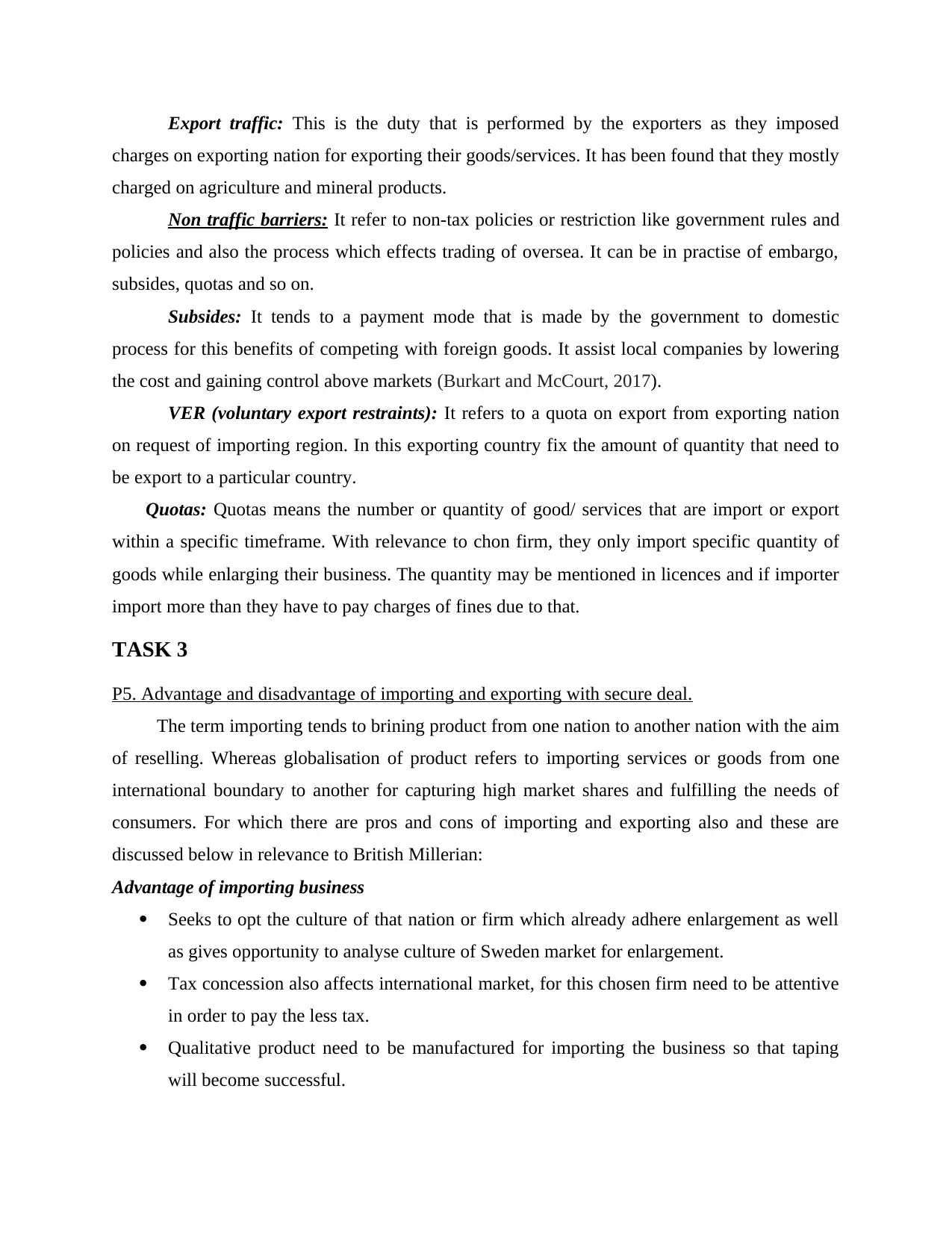
Export traffic: This is the duty that is performed by the exporters as they imposed
charges on exporting nation for exporting their goods/services. It has been found that they mostly
charged on agriculture and mineral products.
Non traffic barriers: It refer to non-tax policies or restriction like government rules and
policies and also the process which effects trading of oversea. It can be in practise of embargo,
subsides, quotas and so on.
Subsides: It tends to a payment mode that is made by the government to domestic
process for this benefits of competing with foreign goods. It assist local companies by lowering
the cost and gaining control above markets (Burkart and McCourt, 2017).
VER (voluntary export restraints): It refers to a quota on export from exporting nation
on request of importing region. In this exporting country fix the amount of quantity that need to
be export to a particular country.
Quotas: Quotas means the number or quantity of good/ services that are import or export
within a specific timeframe. With relevance to chon firm, they only import specific quantity of
goods while enlarging their business. The quantity may be mentioned in licences and if importer
import more than they have to pay charges of fines due to that.
TASK 3
P5. Advantage and disadvantage of importing and exporting with secure deal.
The term importing tends to brining product from one nation to another nation with the aim
of reselling. Whereas globalisation of product refers to importing services or goods from one
international boundary to another for capturing high market shares and fulfilling the needs of
consumers. For which there are pros and cons of importing and exporting also and these are
discussed below in relevance to British Millerian:
Advantage of importing business
Seeks to opt the culture of that nation or firm which already adhere enlargement as well
as gives opportunity to analyse culture of Sweden market for enlargement.
Tax concession also affects international market, for this chosen firm need to be attentive
in order to pay the less tax.
Qualitative product need to be manufactured for importing the business so that taping
will become successful.
charges on exporting nation for exporting their goods/services. It has been found that they mostly
charged on agriculture and mineral products.
Non traffic barriers: It refer to non-tax policies or restriction like government rules and
policies and also the process which effects trading of oversea. It can be in practise of embargo,
subsides, quotas and so on.
Subsides: It tends to a payment mode that is made by the government to domestic
process for this benefits of competing with foreign goods. It assist local companies by lowering
the cost and gaining control above markets (Burkart and McCourt, 2017).
VER (voluntary export restraints): It refers to a quota on export from exporting nation
on request of importing region. In this exporting country fix the amount of quantity that need to
be export to a particular country.
Quotas: Quotas means the number or quantity of good/ services that are import or export
within a specific timeframe. With relevance to chon firm, they only import specific quantity of
goods while enlarging their business. The quantity may be mentioned in licences and if importer
import more than they have to pay charges of fines due to that.
TASK 3
P5. Advantage and disadvantage of importing and exporting with secure deal.
The term importing tends to brining product from one nation to another nation with the aim
of reselling. Whereas globalisation of product refers to importing services or goods from one
international boundary to another for capturing high market shares and fulfilling the needs of
consumers. For which there are pros and cons of importing and exporting also and these are
discussed below in relevance to British Millerian:
Advantage of importing business
Seeks to opt the culture of that nation or firm which already adhere enlargement as well
as gives opportunity to analyse culture of Sweden market for enlargement.
Tax concession also affects international market, for this chosen firm need to be attentive
in order to pay the less tax.
Qualitative product need to be manufactured for importing the business so that taping
will become successful.
Paraphrase This Document
Need a fresh take? Get an instant paraphrase of this document with our AI Paraphraser
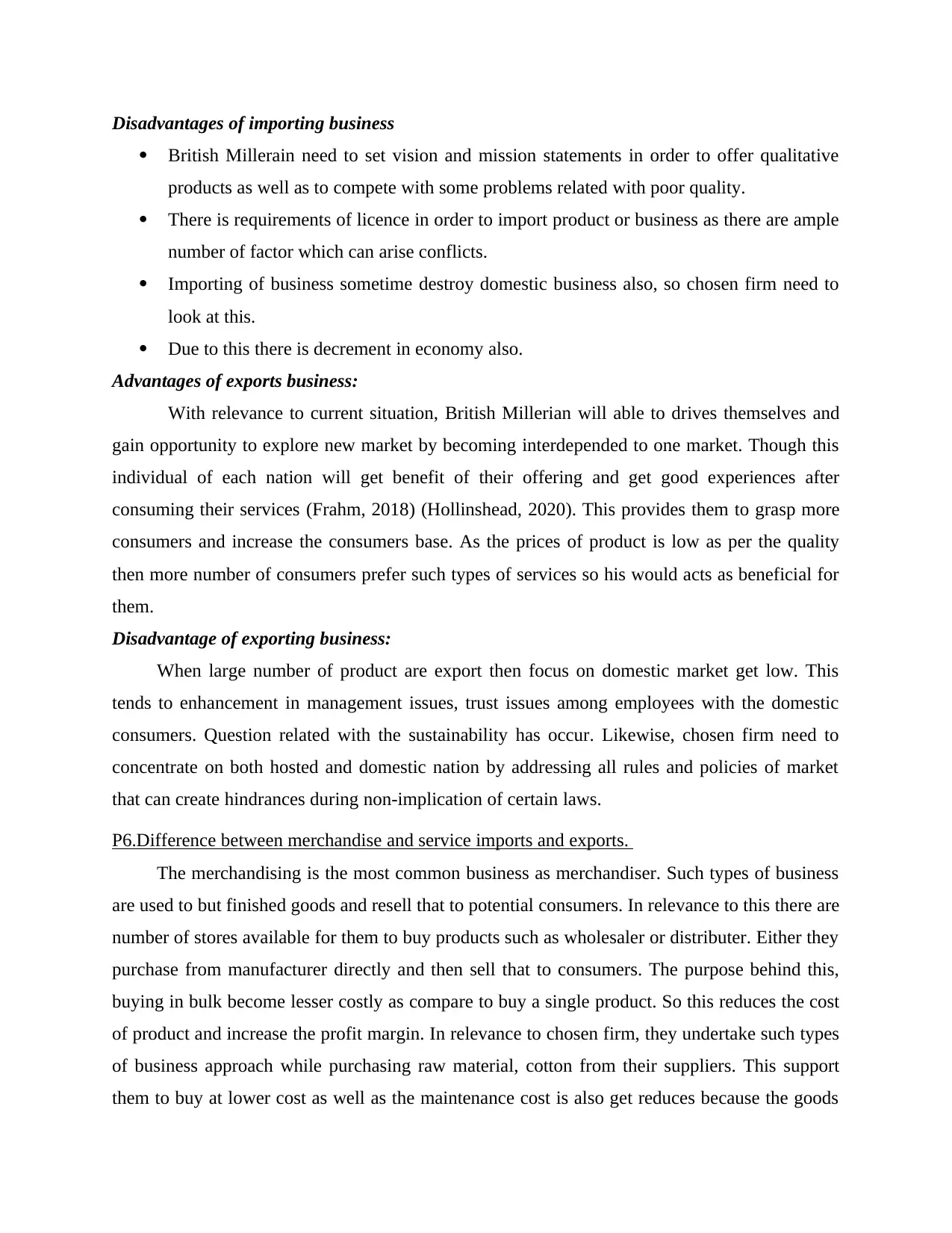
Disadvantages of importing business
British Millerain need to set vision and mission statements in order to offer qualitative
products as well as to compete with some problems related with poor quality.
There is requirements of licence in order to import product or business as there are ample
number of factor which can arise conflicts.
Importing of business sometime destroy domestic business also, so chosen firm need to
look at this.
Due to this there is decrement in economy also.
Advantages of exports business:
With relevance to current situation, British Millerian will able to drives themselves and
gain opportunity to explore new market by becoming interdepended to one market. Though this
individual of each nation will get benefit of their offering and get good experiences after
consuming their services (Frahm, 2018) (Hollinshead, 2020). This provides them to grasp more
consumers and increase the consumers base. As the prices of product is low as per the quality
then more number of consumers prefer such types of services so his would acts as beneficial for
them.
Disadvantage of exporting business:
When large number of product are export then focus on domestic market get low. This
tends to enhancement in management issues, trust issues among employees with the domestic
consumers. Question related with the sustainability has occur. Likewise, chosen firm need to
concentrate on both hosted and domestic nation by addressing all rules and policies of market
that can create hindrances during non-implication of certain laws.
P6.Difference between merchandise and service imports and exports.
The merchandising is the most common business as merchandiser. Such types of business
are used to but finished goods and resell that to potential consumers. In relevance to this there are
number of stores available for them to buy products such as wholesaler or distributer. Either they
purchase from manufacturer directly and then sell that to consumers. The purpose behind this,
buying in bulk become lesser costly as compare to buy a single product. So this reduces the cost
of product and increase the profit margin. In relevance to chosen firm, they undertake such types
of business approach while purchasing raw material, cotton from their suppliers. This support
them to buy at lower cost as well as the maintenance cost is also get reduces because the goods
British Millerain need to set vision and mission statements in order to offer qualitative
products as well as to compete with some problems related with poor quality.
There is requirements of licence in order to import product or business as there are ample
number of factor which can arise conflicts.
Importing of business sometime destroy domestic business also, so chosen firm need to
look at this.
Due to this there is decrement in economy also.
Advantages of exports business:
With relevance to current situation, British Millerian will able to drives themselves and
gain opportunity to explore new market by becoming interdepended to one market. Though this
individual of each nation will get benefit of their offering and get good experiences after
consuming their services (Frahm, 2018) (Hollinshead, 2020). This provides them to grasp more
consumers and increase the consumers base. As the prices of product is low as per the quality
then more number of consumers prefer such types of services so his would acts as beneficial for
them.
Disadvantage of exporting business:
When large number of product are export then focus on domestic market get low. This
tends to enhancement in management issues, trust issues among employees with the domestic
consumers. Question related with the sustainability has occur. Likewise, chosen firm need to
concentrate on both hosted and domestic nation by addressing all rules and policies of market
that can create hindrances during non-implication of certain laws.
P6.Difference between merchandise and service imports and exports.
The merchandising is the most common business as merchandiser. Such types of business
are used to but finished goods and resell that to potential consumers. In relevance to this there are
number of stores available for them to buy products such as wholesaler or distributer. Either they
purchase from manufacturer directly and then sell that to consumers. The purpose behind this,
buying in bulk become lesser costly as compare to buy a single product. So this reduces the cost
of product and increase the profit margin. In relevance to chosen firm, they undertake such types
of business approach while purchasing raw material, cotton from their suppliers. This support
them to buy at lower cost as well as the maintenance cost is also get reduces because the goods
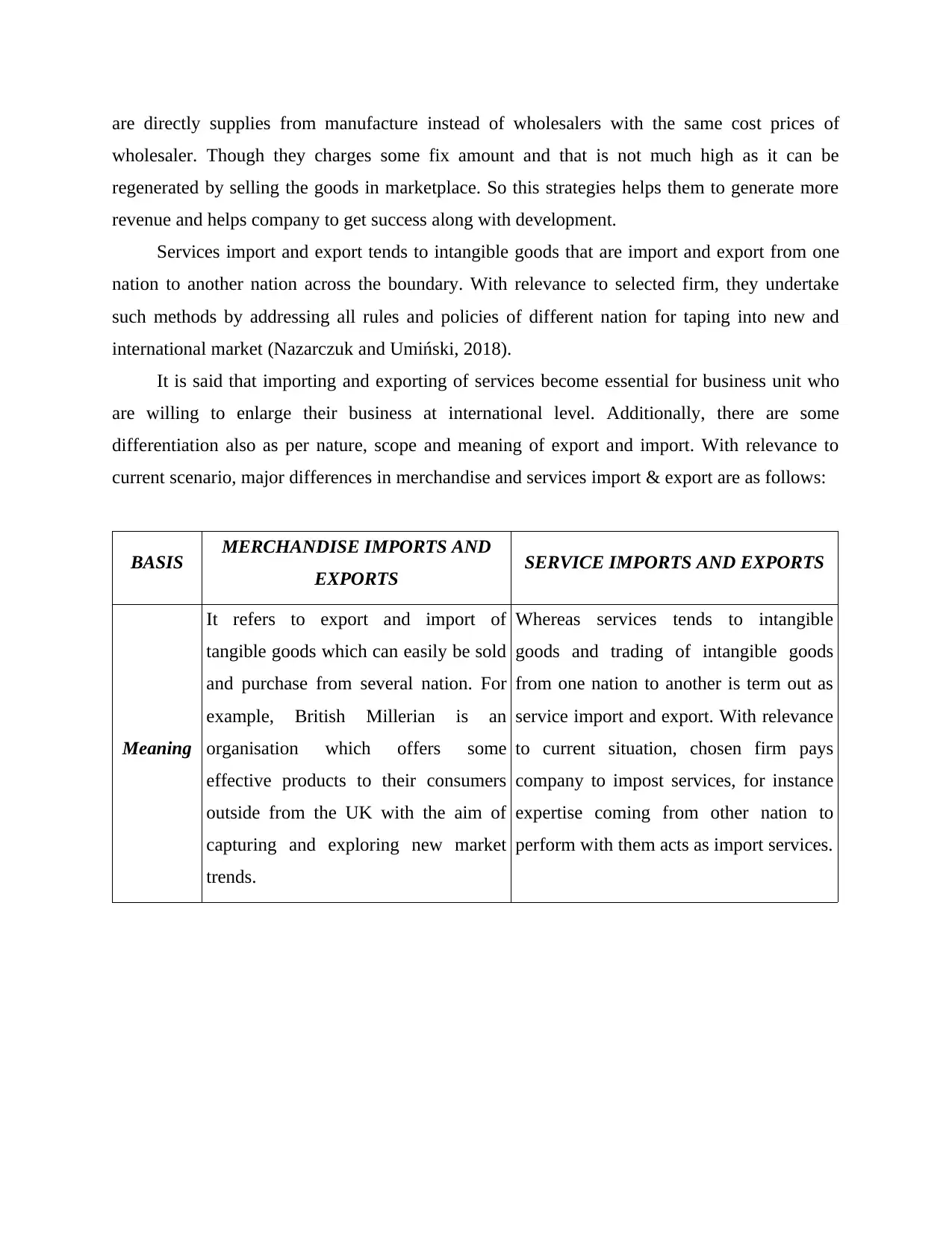
are directly supplies from manufacture instead of wholesalers with the same cost prices of
wholesaler. Though they charges some fix amount and that is not much high as it can be
regenerated by selling the goods in marketplace. So this strategies helps them to generate more
revenue and helps company to get success along with development.
Services import and export tends to intangible goods that are import and export from one
nation to another nation across the boundary. With relevance to selected firm, they undertake
such methods by addressing all rules and policies of different nation for taping into new and
international market (Nazarczuk and Umiński, 2018).
It is said that importing and exporting of services become essential for business unit who
are willing to enlarge their business at international level. Additionally, there are some
differentiation also as per nature, scope and meaning of export and import. With relevance to
current scenario, major differences in merchandise and services import & export are as follows:
BASIS MERCHANDISE IMPORTS AND
EXPORTS SERVICE IMPORTS AND EXPORTS
Meaning
It refers to export and import of
tangible goods which can easily be sold
and purchase from several nation. For
example, British Millerian is an
organisation which offers some
effective products to their consumers
outside from the UK with the aim of
capturing and exploring new market
trends.
Whereas services tends to intangible
goods and trading of intangible goods
from one nation to another is term out as
service import and export. With relevance
to current situation, chosen firm pays
company to impost services, for instance
expertise coming from other nation to
perform with them acts as import services.
wholesaler. Though they charges some fix amount and that is not much high as it can be
regenerated by selling the goods in marketplace. So this strategies helps them to generate more
revenue and helps company to get success along with development.
Services import and export tends to intangible goods that are import and export from one
nation to another nation across the boundary. With relevance to selected firm, they undertake
such methods by addressing all rules and policies of different nation for taping into new and
international market (Nazarczuk and Umiński, 2018).
It is said that importing and exporting of services become essential for business unit who
are willing to enlarge their business at international level. Additionally, there are some
differentiation also as per nature, scope and meaning of export and import. With relevance to
current scenario, major differences in merchandise and services import & export are as follows:
BASIS MERCHANDISE IMPORTS AND
EXPORTS SERVICE IMPORTS AND EXPORTS
Meaning
It refers to export and import of
tangible goods which can easily be sold
and purchase from several nation. For
example, British Millerian is an
organisation which offers some
effective products to their consumers
outside from the UK with the aim of
capturing and exploring new market
trends.
Whereas services tends to intangible
goods and trading of intangible goods
from one nation to another is term out as
service import and export. With relevance
to current situation, chosen firm pays
company to impost services, for instance
expertise coming from other nation to
perform with them acts as import services.
⊘ This is a preview!⊘
Do you want full access?
Subscribe today to unlock all pages.

Trusted by 1+ million students worldwide
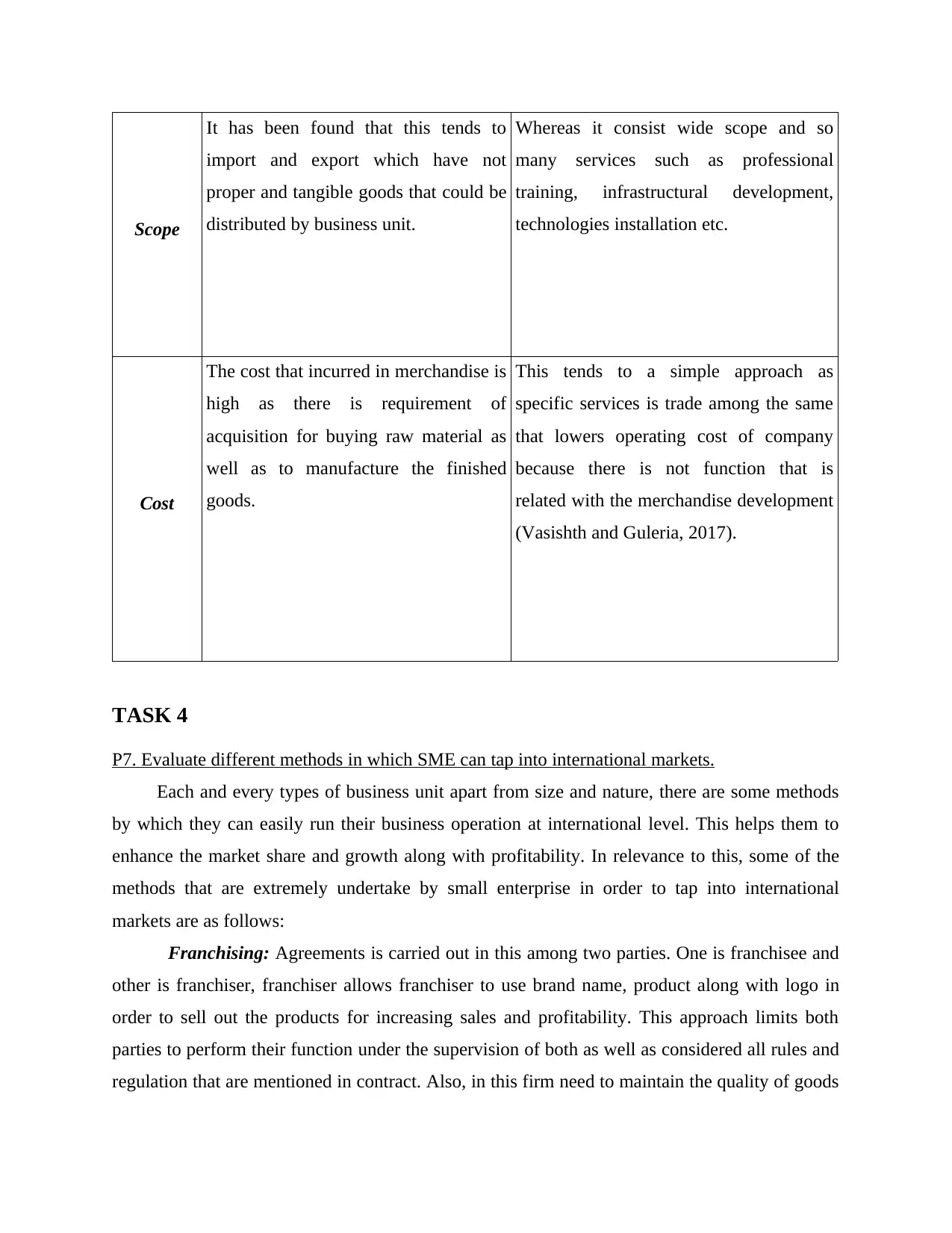
Scope
It has been found that this tends to
import and export which have not
proper and tangible goods that could be
distributed by business unit.
Whereas it consist wide scope and so
many services such as professional
training, infrastructural development,
technologies installation etc.
Cost
The cost that incurred in merchandise is
high as there is requirement of
acquisition for buying raw material as
well as to manufacture the finished
goods.
This tends to a simple approach as
specific services is trade among the same
that lowers operating cost of company
because there is not function that is
related with the merchandise development
(Vasishth and Guleria, 2017).
TASK 4
P7. Evaluate different methods in which SME can tap into international markets.
Each and every types of business unit apart from size and nature, there are some methods
by which they can easily run their business operation at international level. This helps them to
enhance the market share and growth along with profitability. In relevance to this, some of the
methods that are extremely undertake by small enterprise in order to tap into international
markets are as follows:
Franchising: Agreements is carried out in this among two parties. One is franchisee and
other is franchiser, franchiser allows franchiser to use brand name, product along with logo in
order to sell out the products for increasing sales and profitability. This approach limits both
parties to perform their function under the supervision of both as well as considered all rules and
regulation that are mentioned in contract. Also, in this firm need to maintain the quality of goods
It has been found that this tends to
import and export which have not
proper and tangible goods that could be
distributed by business unit.
Whereas it consist wide scope and so
many services such as professional
training, infrastructural development,
technologies installation etc.
Cost
The cost that incurred in merchandise is
high as there is requirement of
acquisition for buying raw material as
well as to manufacture the finished
goods.
This tends to a simple approach as
specific services is trade among the same
that lowers operating cost of company
because there is not function that is
related with the merchandise development
(Vasishth and Guleria, 2017).
TASK 4
P7. Evaluate different methods in which SME can tap into international markets.
Each and every types of business unit apart from size and nature, there are some methods
by which they can easily run their business operation at international level. This helps them to
enhance the market share and growth along with profitability. In relevance to this, some of the
methods that are extremely undertake by small enterprise in order to tap into international
markets are as follows:
Franchising: Agreements is carried out in this among two parties. One is franchisee and
other is franchiser, franchiser allows franchiser to use brand name, product along with logo in
order to sell out the products for increasing sales and profitability. This approach limits both
parties to perform their function under the supervision of both as well as considered all rules and
regulation that are mentioned in contract. Also, in this firm need to maintain the quality of goods
Paraphrase This Document
Need a fresh take? Get an instant paraphrase of this document with our AI Paraphraser
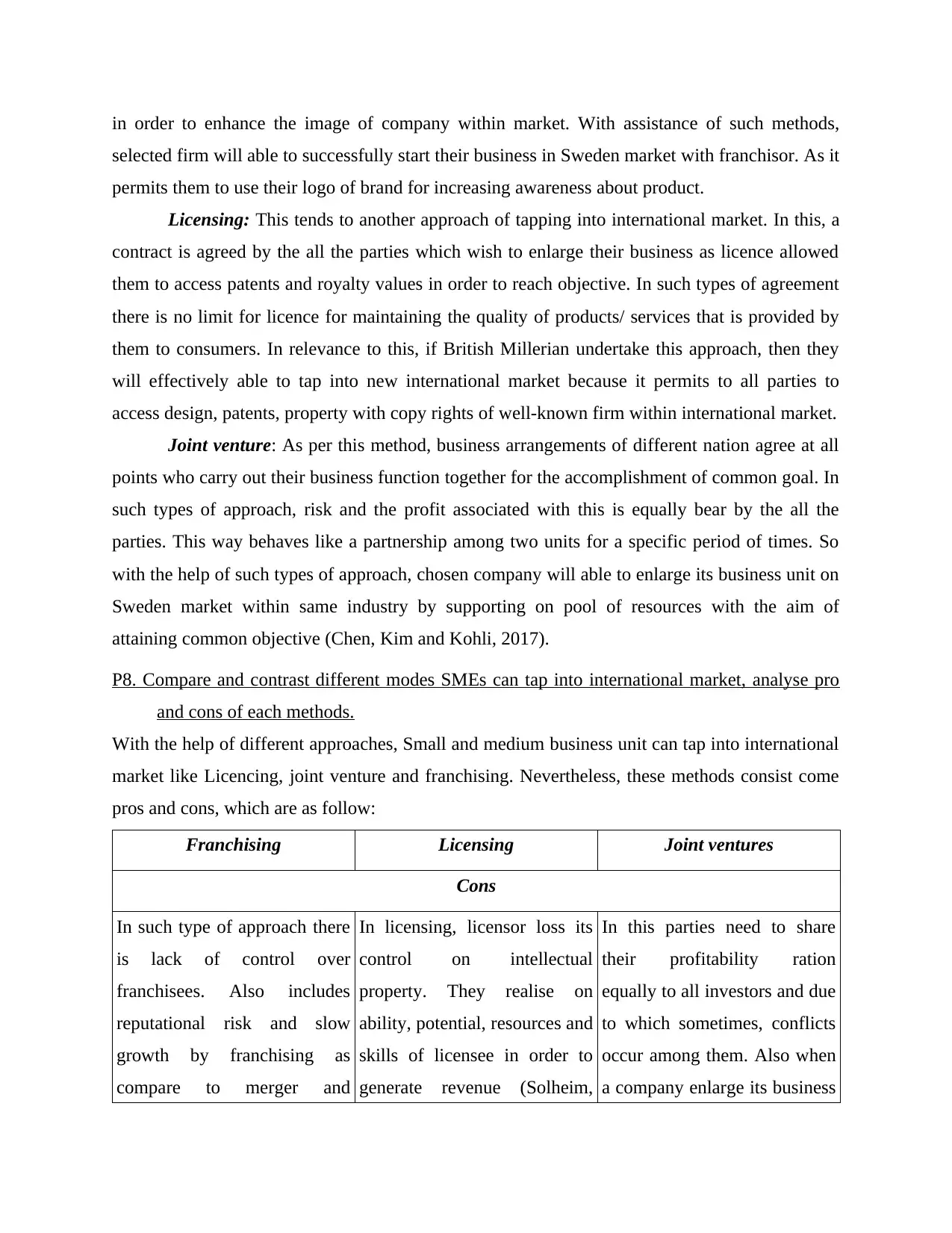
in order to enhance the image of company within market. With assistance of such methods,
selected firm will able to successfully start their business in Sweden market with franchisor. As it
permits them to use their logo of brand for increasing awareness about product.
Licensing: This tends to another approach of tapping into international market. In this, a
contract is agreed by the all the parties which wish to enlarge their business as licence allowed
them to access patents and royalty values in order to reach objective. In such types of agreement
there is no limit for licence for maintaining the quality of products/ services that is provided by
them to consumers. In relevance to this, if British Millerian undertake this approach, then they
will effectively able to tap into new international market because it permits to all parties to
access design, patents, property with copy rights of well-known firm within international market.
Joint venture: As per this method, business arrangements of different nation agree at all
points who carry out their business function together for the accomplishment of common goal. In
such types of approach, risk and the profit associated with this is equally bear by the all the
parties. This way behaves like a partnership among two units for a specific period of times. So
with the help of such types of approach, chosen company will able to enlarge its business unit on
Sweden market within same industry by supporting on pool of resources with the aim of
attaining common objective (Chen, Kim and Kohli, 2017).
P8. Compare and contrast different modes SMEs can tap into international market, analyse pro
and cons of each methods.
With the help of different approaches, Small and medium business unit can tap into international
market like Licencing, joint venture and franchising. Nevertheless, these methods consist come
pros and cons, which are as follow:
Franchising Licensing Joint ventures
Cons
In such type of approach there
is lack of control over
franchisees. Also includes
reputational risk and slow
growth by franchising as
compare to merger and
In licensing, licensor loss its
control on intellectual
property. They realise on
ability, potential, resources and
skills of licensee in order to
generate revenue (Solheim,
In this parties need to share
their profitability ration
equally to all investors and due
to which sometimes, conflicts
occur among them. Also when
a company enlarge its business
selected firm will able to successfully start their business in Sweden market with franchisor. As it
permits them to use their logo of brand for increasing awareness about product.
Licensing: This tends to another approach of tapping into international market. In this, a
contract is agreed by the all the parties which wish to enlarge their business as licence allowed
them to access patents and royalty values in order to reach objective. In such types of agreement
there is no limit for licence for maintaining the quality of products/ services that is provided by
them to consumers. In relevance to this, if British Millerian undertake this approach, then they
will effectively able to tap into new international market because it permits to all parties to
access design, patents, property with copy rights of well-known firm within international market.
Joint venture: As per this method, business arrangements of different nation agree at all
points who carry out their business function together for the accomplishment of common goal. In
such types of approach, risk and the profit associated with this is equally bear by the all the
parties. This way behaves like a partnership among two units for a specific period of times. So
with the help of such types of approach, chosen company will able to enlarge its business unit on
Sweden market within same industry by supporting on pool of resources with the aim of
attaining common objective (Chen, Kim and Kohli, 2017).
P8. Compare and contrast different modes SMEs can tap into international market, analyse pro
and cons of each methods.
With the help of different approaches, Small and medium business unit can tap into international
market like Licencing, joint venture and franchising. Nevertheless, these methods consist come
pros and cons, which are as follow:
Franchising Licensing Joint ventures
Cons
In such type of approach there
is lack of control over
franchisees. Also includes
reputational risk and slow
growth by franchising as
compare to merger and
In licensing, licensor loss its
control on intellectual
property. They realise on
ability, potential, resources and
skills of licensee in order to
generate revenue (Solheim,
In this parties need to share
their profitability ration
equally to all investors and due
to which sometimes, conflicts
occur among them. Also when
a company enlarge its business
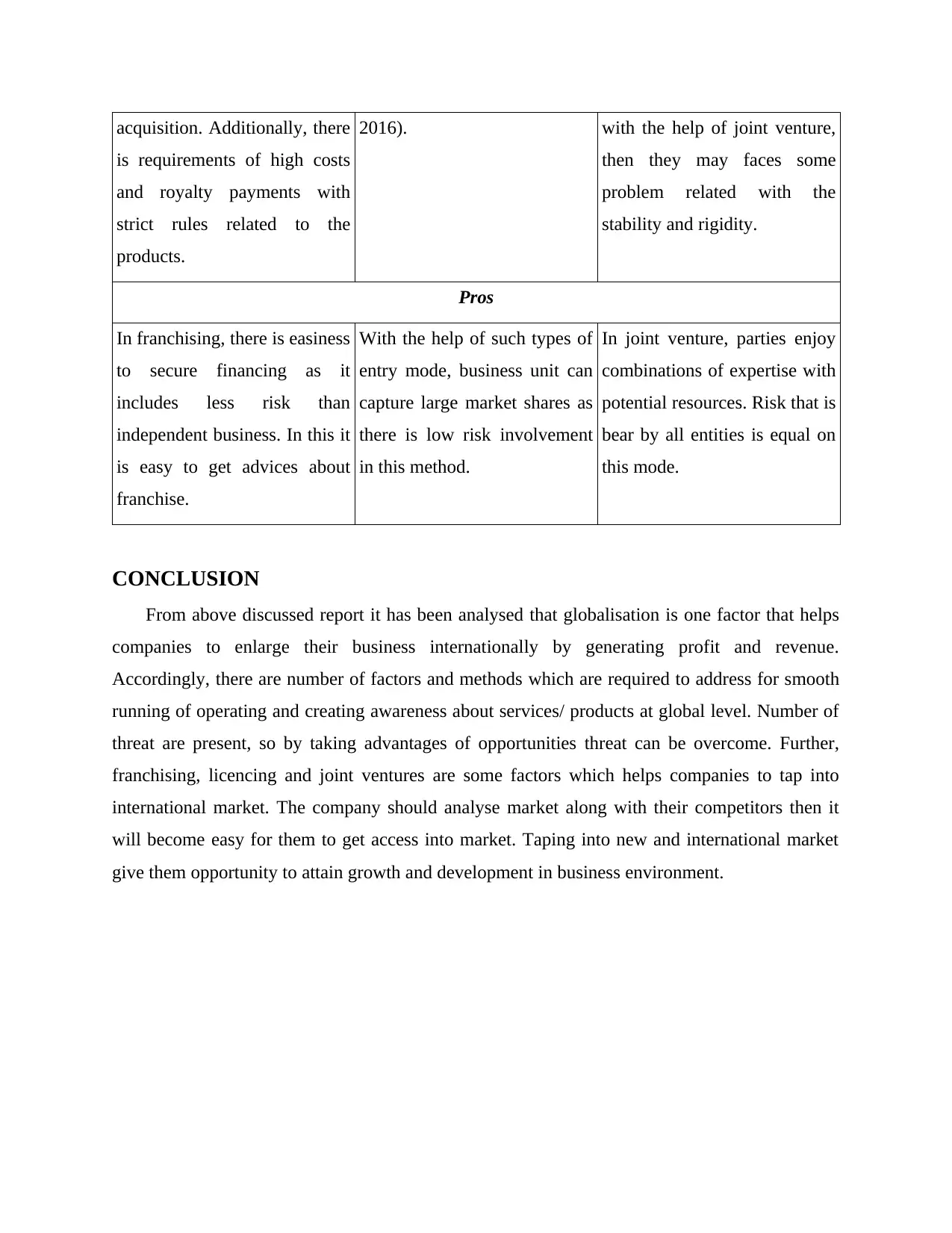
acquisition. Additionally, there
is requirements of high costs
and royalty payments with
strict rules related to the
products.
2016). with the help of joint venture,
then they may faces some
problem related with the
stability and rigidity.
Pros
In franchising, there is easiness
to secure financing as it
includes less risk than
independent business. In this it
is easy to get advices about
franchise.
With the help of such types of
entry mode, business unit can
capture large market shares as
there is low risk involvement
in this method.
In joint venture, parties enjoy
combinations of expertise with
potential resources. Risk that is
bear by all entities is equal on
this mode.
CONCLUSION
From above discussed report it has been analysed that globalisation is one factor that helps
companies to enlarge their business internationally by generating profit and revenue.
Accordingly, there are number of factors and methods which are required to address for smooth
running of operating and creating awareness about services/ products at global level. Number of
threat are present, so by taking advantages of opportunities threat can be overcome. Further,
franchising, licencing and joint ventures are some factors which helps companies to tap into
international market. The company should analyse market along with their competitors then it
will become easy for them to get access into market. Taping into new and international market
give them opportunity to attain growth and development in business environment.
is requirements of high costs
and royalty payments with
strict rules related to the
products.
2016). with the help of joint venture,
then they may faces some
problem related with the
stability and rigidity.
Pros
In franchising, there is easiness
to secure financing as it
includes less risk than
independent business. In this it
is easy to get advices about
franchise.
With the help of such types of
entry mode, business unit can
capture large market shares as
there is low risk involvement
in this method.
In joint venture, parties enjoy
combinations of expertise with
potential resources. Risk that is
bear by all entities is equal on
this mode.
CONCLUSION
From above discussed report it has been analysed that globalisation is one factor that helps
companies to enlarge their business internationally by generating profit and revenue.
Accordingly, there are number of factors and methods which are required to address for smooth
running of operating and creating awareness about services/ products at global level. Number of
threat are present, so by taking advantages of opportunities threat can be overcome. Further,
franchising, licencing and joint ventures are some factors which helps companies to tap into
international market. The company should analyse market along with their competitors then it
will become easy for them to get access into market. Taping into new and international market
give them opportunity to attain growth and development in business environment.
⊘ This is a preview!⊘
Do you want full access?
Subscribe today to unlock all pages.

Trusted by 1+ million students worldwide
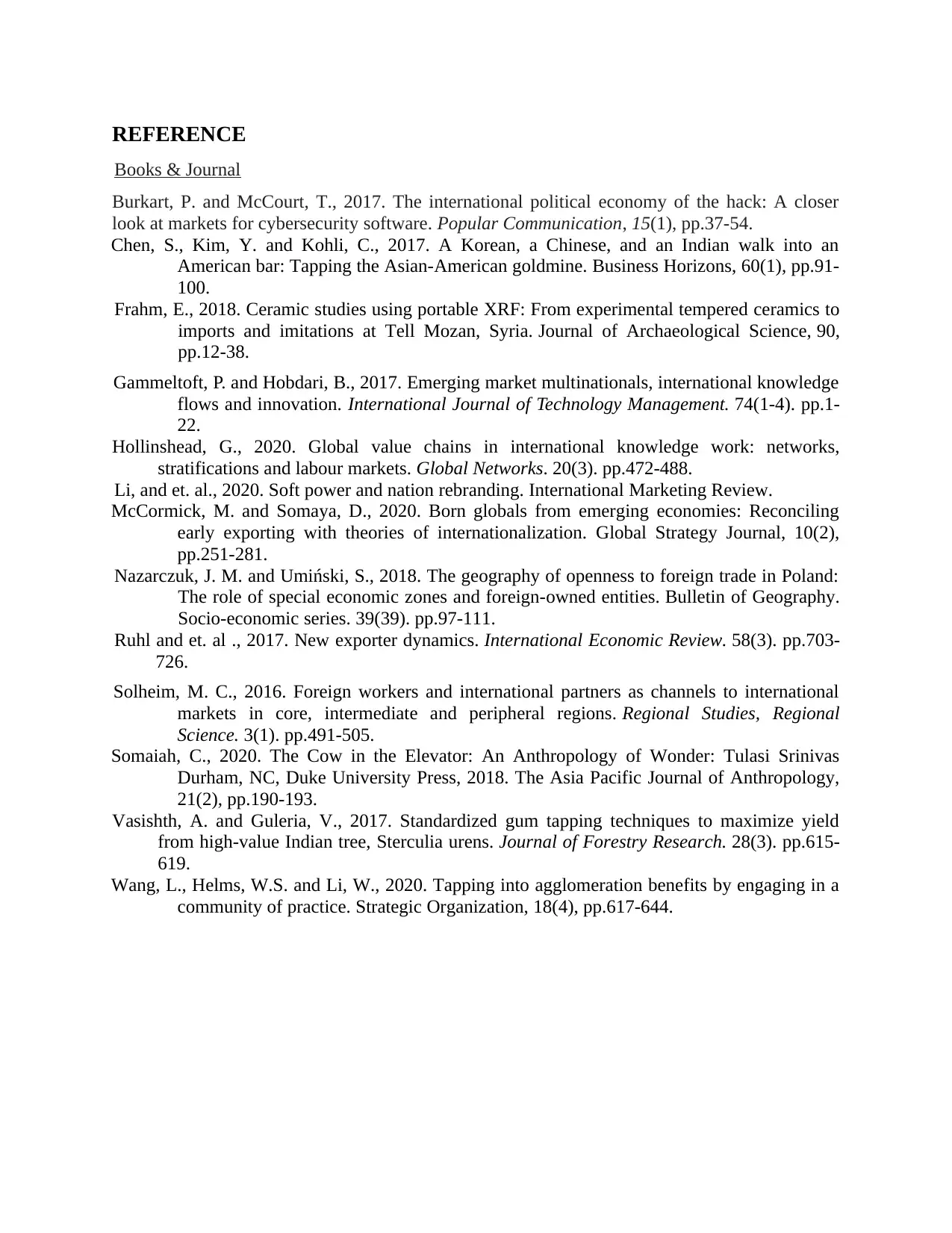
REFERENCE
Books & Journal
Burkart, P. and McCourt, T., 2017. The international political economy of the hack: A closer
look at markets for cybersecurity software. Popular Communication, 15(1), pp.37-54.
Chen, S., Kim, Y. and Kohli, C., 2017. A Korean, a Chinese, and an Indian walk into an
American bar: Tapping the Asian-American goldmine. Business Horizons, 60(1), pp.91-
100.
Frahm, E., 2018. Ceramic studies using portable XRF: From experimental tempered ceramics to
imports and imitations at Tell Mozan, Syria. Journal of Archaeological Science, 90,
pp.12-38.
Gammeltoft, P. and Hobdari, B., 2017. Emerging market multinationals, international knowledge
flows and innovation. International Journal of Technology Management. 74(1-4). pp.1-
22.
Hollinshead, G., 2020. Global value chains in international knowledge work: networks,
stratifications and labour markets. Global Networks. 20(3). pp.472-488.
Li, and et. al., 2020. Soft power and nation rebranding. International Marketing Review.
McCormick, M. and Somaya, D., 2020. Born globals from emerging economies: Reconciling
early exporting with theories of internationalization. Global Strategy Journal, 10(2),
pp.251-281.
Nazarczuk, J. M. and Umiński, S., 2018. The geography of openness to foreign trade in Poland:
The role of special economic zones and foreign-owned entities. Bulletin of Geography.
Socio-economic series. 39(39). pp.97-111.
Ruhl and et. al ., 2017. New exporter dynamics. International Economic Review. 58(3). pp.703-
726.
Solheim, M. C., 2016. Foreign workers and international partners as channels to international
markets in core, intermediate and peripheral regions. Regional Studies, Regional
Science. 3(1). pp.491-505.
Somaiah, C., 2020. The Cow in the Elevator: An Anthropology of Wonder: Tulasi Srinivas
Durham, NC, Duke University Press, 2018. The Asia Pacific Journal of Anthropology,
21(2), pp.190-193.
Vasishth, A. and Guleria, V., 2017. Standardized gum tapping techniques to maximize yield
from high-value Indian tree, Sterculia urens. Journal of Forestry Research. 28(3). pp.615-
619.
Wang, L., Helms, W.S. and Li, W., 2020. Tapping into agglomeration benefits by engaging in a
community of practice. Strategic Organization, 18(4), pp.617-644.
Books & Journal
Burkart, P. and McCourt, T., 2017. The international political economy of the hack: A closer
look at markets for cybersecurity software. Popular Communication, 15(1), pp.37-54.
Chen, S., Kim, Y. and Kohli, C., 2017. A Korean, a Chinese, and an Indian walk into an
American bar: Tapping the Asian-American goldmine. Business Horizons, 60(1), pp.91-
100.
Frahm, E., 2018. Ceramic studies using portable XRF: From experimental tempered ceramics to
imports and imitations at Tell Mozan, Syria. Journal of Archaeological Science, 90,
pp.12-38.
Gammeltoft, P. and Hobdari, B., 2017. Emerging market multinationals, international knowledge
flows and innovation. International Journal of Technology Management. 74(1-4). pp.1-
22.
Hollinshead, G., 2020. Global value chains in international knowledge work: networks,
stratifications and labour markets. Global Networks. 20(3). pp.472-488.
Li, and et. al., 2020. Soft power and nation rebranding. International Marketing Review.
McCormick, M. and Somaya, D., 2020. Born globals from emerging economies: Reconciling
early exporting with theories of internationalization. Global Strategy Journal, 10(2),
pp.251-281.
Nazarczuk, J. M. and Umiński, S., 2018. The geography of openness to foreign trade in Poland:
The role of special economic zones and foreign-owned entities. Bulletin of Geography.
Socio-economic series. 39(39). pp.97-111.
Ruhl and et. al ., 2017. New exporter dynamics. International Economic Review. 58(3). pp.703-
726.
Solheim, M. C., 2016. Foreign workers and international partners as channels to international
markets in core, intermediate and peripheral regions. Regional Studies, Regional
Science. 3(1). pp.491-505.
Somaiah, C., 2020. The Cow in the Elevator: An Anthropology of Wonder: Tulasi Srinivas
Durham, NC, Duke University Press, 2018. The Asia Pacific Journal of Anthropology,
21(2), pp.190-193.
Vasishth, A. and Guleria, V., 2017. Standardized gum tapping techniques to maximize yield
from high-value Indian tree, Sterculia urens. Journal of Forestry Research. 28(3). pp.615-
619.
Wang, L., Helms, W.S. and Li, W., 2020. Tapping into agglomeration benefits by engaging in a
community of practice. Strategic Organization, 18(4), pp.617-644.
1 out of 13
Related Documents
Your All-in-One AI-Powered Toolkit for Academic Success.
+13062052269
info@desklib.com
Available 24*7 on WhatsApp / Email
![[object Object]](/_next/static/media/star-bottom.7253800d.svg)
Unlock your academic potential
© 2024 | Zucol Services PVT LTD | All rights reserved.





